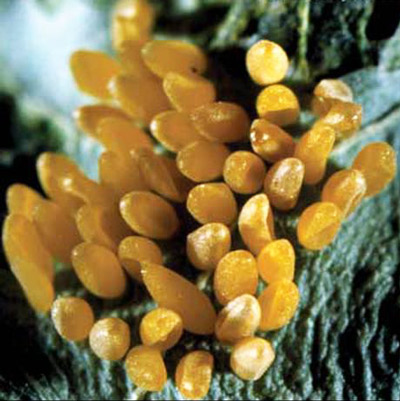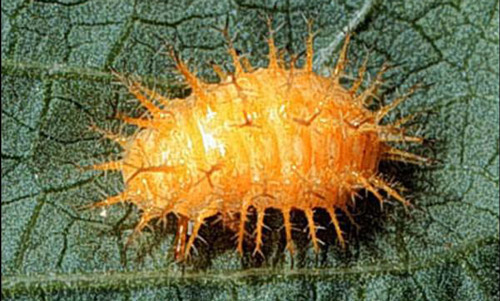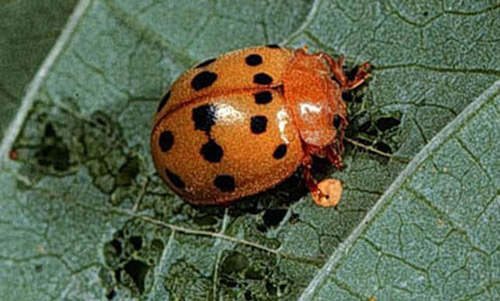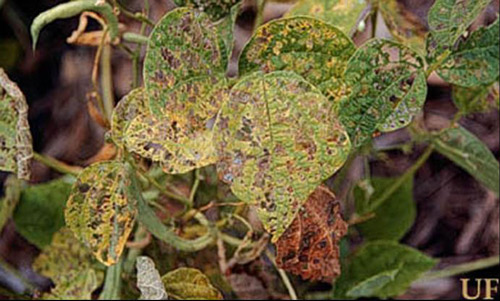common name: Mexican bean beetle (suggested common name)
scientific name: Epilachna varivestis Mulsant (Insecta: Coleoptera: Coccinellidae)
Introduction - Distribution - Description - Life Cycle - Hosts - Damage - Economic Injury Level - Management - Selected References
Introduction (Back to Top)
The family Coccinellidae, or ladybird beetles, is in the order Coleoptera. This family is very important economically because it includes some highly beneficial insects as well as two serious pests: the squash lady beetle, Epilachna borealis Fabricius, and the Mexican bean beetle, Epilachna varivestis Mulsant.
The Mexican bean beetle has a complete metamorphosis with distinct egg, larval, pupal and adult stages. Unlike most of the Coccinellidae which are carnivorous and feed upon aphids, scales and other small insects, this species attacks plants.
Distribution (Back to Top)
The Mexican bean beetle is believed to be native to the plateau region of southern Mexico. This insect is found in the United States (in most states east of the Rocky Mountains) and Mexico. In eastern regions, the pest is present wherever beans are grown, while western infestations are in isolated areas, depending upon the local environment and precipitation. The insect is not a serious pest in Guatemala and Mexico, but is very abundant in several areas in the western United States. The southern limit of the known distribution is in Guatemala and the northern limit is southern Canada and New England. It was reported and apparently eradicated from Florida in 1933, but was found again in 1938 and by 1942 was firmly established.
Description (Back to Top)
Eggs: Eggs are approximately 1.3 mm in length and 0.6 mm in width, and are pale yellow to orange-yellow in color. They are typically found in clusters of 40 to 75 on the undersides of bean leaves.
Figure 1. Mexican bean beetle, Epilachna varivestis Mulsant, eggs. Photograph by John Capinera, University of Florida.
Larva: The newly-hatched larva is light yellow in color and not over 1.6 mm in length. The body is covered with rows of stout branched spines, arranged in six longitudinal rows on the backs. The spines at first are yellow, but later become darker at the tips and more conspicuous. The larva has a soft body that tapers posteriorly and has an anal segment having a sucker-like apparatus for attachment to feeding surfaces. The mature larva is from 6.0 to 9.5 mm in length, and greenish yellow. The larva molts four times during the time of development. A few hours after molting, the tips of the spines become darker, giving a general greenish or dirty yellow color. Larvae have a tendency to aggregate in considerable numbers for pupation.
Figure 2. Larva of Mexican bean beetle, Epilachna varivestis Mulsant. Photograph by James Castner, University of Florida.
Pupa: The larva, when mature, attaches itself by the posterior end of the body to the underside of leaves, stems, or pods of the bean plants and often to parts of nearby plants. In this position, the larva pupates. After attaching, the larval skin is pushed back from the thorax to the abdomen where it remains in a whitish, wrinkled mass. The black tips of the spines remain conspicuous on the cast skin. The pupa is yellow, spineless, and of about the size and shape of the adult.
Adult: The adult is oval in outline, and about 6 to 7 mm in length. The newly emerged adult is of a straw or cream-yellow color. Shortly after emergence, eight black spots of variable size appear on each wing cover, arranged in three longitudinal rows on each wing cover. The adults darken with age until they become an orange-brown with a bronze tinge, at which time the black spots are less conspicuous. The males are slightly smaller than the females. Males can be distinguished from females by having a small notch on the ventral side of the last abdominal segment.
Figure 3. Adult Mexican bean beetle, Epilachna varivestis Mulsant. Photograph by James Castner, University of Florida.
Life Cycle (Back to Top)
The adult beetles come out from where they have spent the winter months under brush or leaves, as soon as warm weather arrives. Some may, however, delay their appearance until mid-summer. In mid-May adults tend to search out snap and lima beans, but by late June they begin ovipositing in soybeans. After feeding on the tender young bean plants for one to two weeks, the females lay their eggs, each depositing 500 to 600 of them in batches of 40 to 75 on the underside of the foliage. The eggs are carefully attached at the end so that they all stand vertically. They hatch in a week during warm weather but may require at least two weeks under cooler conditions.
The larvae feed voraciously for two to five weeks, depending upon the temperature. When first hatched, they all feed together. If the leaf is somewhat dry, the first hatched may devour the remaining unhatched eggs. As they grow older, they still retain their gregarious habits but tend to split up into small, scattered groups. When pupating, the larva fastens the tip of the abdomen to a part of the plant and starts to wiggle out of the larval skin, not entirely shedding it but pushing it back until only the tip of the abdomen remains in the skin. The pupal stage lasts for five to ten days, but may drag out much longer in the cool weather of autumn. The adults are strong fliers and travel long distances hunting for new bean fields. The beetles overwinter in moist, protected places, remaining dormant until spring.
Hosts (Back to Top)
Bean is the preferred host, and includes most varieties of snap beans and lima beans, Phaseolus vulgaris L. and Phaseolus lunatus L. The common weed beggarweed (Desmodium sp.) is believed to be a natural host. The insect can live on cowpea, black-eyed pea, and soybean, and may attack mung, adzuki, velvet bean, alfalfa, and clover. In some areas this beetle is a very serious pest of snapbean, lima bean, and soybean, and during years of high infestation total defoliation of these plants is common. Soybeans are especially vulnerable to insect defoliation when plants are in the podset-podfill stages.
Damage (Back to Top)
The insect in both the larval and adult stages will feed upon the leaves, flowers and pods of the bean plant, but the greatest amount of injury is done to the leaves. The larvae cause more damage than the adult beetles. They feed by clinging to the lower surface of the leaves and eating irregular sections of the lower leaf surface. The upper surface of the leaves dries out after the lower section is injured, giving a lace-like, skeletonized appearance. Occasionally blossoms, and in many cases small pods, will be entirely destroyed.
Figure 4. Damage caused by the Mexican bean beetle, Epilachna varnestis Mulsant. Photograph by James Castner, University of Florida.
Economic Injury Level (Back to Top)
Prior to the development of economic injury levels for soybean insects, applications of insecticides were often made at the mere sight of a pest population. Economic injury levels are based on knowledge of insect feeding and development, the plant's response to defoliation, cost of insecticide application and price of soybean. Using this method, growers found that insect populations could be tolerated without insecticides being needed. The most important aspect of the relationship between insect injury and crop response is that soybean can compensate for low levels of defoliation. This natural tolerance allows growers to accept some injury knowing that yield losses will not occur.
To estimate the economic threshold for this insect, the following criteria must be determined 1) the dollar loss associated with a specific number of Mexican bean beetle larvae per unit area; and 2) the cost of the control (insecticide and application costs) on the same unit area. When criterion 1 equals criterion 2, control becomes economically feasible and the economic threshold has been reached. Various yield loss-treatment cost analyses have determined the threshold level to range from 1 to 1.5 larvae/plant on beans. This varies depending upon the bean variety and growing conditions. Current pest management guidelines for control of Mexican bean beetle on soybean suggest applying controls when 30 to 35 percent defoliation is observed prior to full bloom and 15 percent during pod-set and podfill. Economic levels of infestation usually do not appear until the onset of the second generation in late July or August, when soybeans are most susceptible to insect feeding.
Rescue treatment with an insecticide is warranted when defoliation is greater than 40 percent at pre-bloom, greater than 15 percent from blooming to pod-fill, and greater than 25 percent from full pod to harvest. Treatments should be applied only when the observed level of defoliation and number of Mexican bean beetles both indicate that damage will increase.
Management (Back to Top)
To provide crop protection against large immigrating populations, a pesticide should have a high initial efficacy against Mexican bean beetle adults and larvae and residual activity sufficient to suppress any migrating adults.
Cultural Control: Cultural control efforts may include destruction of overwintering locations and late planting of the soybean crop. The destruction of overwintering locations increases the beetle’s exposure to inclement weather conditions and can greatly reduce adult numbers the following spring. Under certain conditions, a combination of a trap crop with delayed planting may be used. Since overwintering beetles actively forage upon emergence in the spring, beans planted early will attract a disproportionate number of beetles feeding during their preoviposition period.
Biological Control: Biological control organisms include at least 17 species of predators that feed on bean beetle eggs, larvae and pupae. The beetles are protected by hard wing covers and by an offensive, yellow liquid which is secreted in small drops from the leg joints when the insects are disturbed.
Figure 5. A Mexican bean beetle larva, Epilachna varivestis Mulsant, becomes a meal for the spined soldier bug instead. Photograph by USDA.
Ten species of parasitoids are prevalent in soybeans during the vegetative stages, but only the tachinid fly Paradexodes epilachnae and the eulophid wasp Pediobius foveolatus seem to be promising in reducing the number of bean beetles. Because Paradexodes epilachnae is not native, it is necessary to import it when the Mexican bean beetle is an important pest. Pediobius foveolatus is a parasitoid of epilachnine beetles from India. It parasitizes Mexican bean beetle larvae during the growing season, but fails to overwinter for lack of diapause capability and/or available host material. The annual releases of this insect, if conducted early enough and in conjunction with establishment of nurse plot areas of snap beans in a widespread manner, are capable of suppression of the Mexican bean beetle on soybeans.
Resistant varieties: It has been reported that some varietal differences in leaf feeding damage from Mexican bean beetle exist among common beans. Lima beans are less preferred than snapbean. Among snapbeans, the group called wax beans tends to be especially preferred. Other types of beans such as mung beans, Phaseolus aureus, cowpea, Vigna sinensis, and soybeans, Glycine max, are not preferred hosts but may be damaged if grown near snap and lima beans, more preferred hosts.
Insecticides: For curative control in outbreak circumstances, several insecticides are currently available. Selection of an appropriate insecticide and timing of its application are very important. Application of systemic insecticides at planting has become a standard practice in many areas where Mexican bean beetle has become an economic pest. Some recommended systemic insecticides do not provide protection long enough to prevent economic damage from either first or second generation populations of the Mexican bean beetle.
Insecticides recommended for treatment of Mexican bean beetle are found in the Florida Insect Management Guide:
Florida Insect Management Guide for legumes
Florida Insect Management Guide for soybeans
Selected References (Back to Top)
- Auclair JL. 1959. Life-history, effects of temperature and relative humidity, and distribution of the Mexican bean beetle, Epilachna varivestis Mulsant (Coleoptera: Coccinellidae) in Quebec, with a review of the pertinent literature in North America. Ann. Soc. Entomol. Quebec 5: 18-43.
- Biddle AJ, Hutchins SH, Wightman JA. 1992. Pests of leguminous crops. In Vegetable Crop Pests. (Ed. R. G. McKinlay) CRC Press, Boca Raton, FL.
- Capinera JL. 2001. Handbook of Vegetable Pests. Academic Press, San Diego. 729 pp.
- Dobrin GC, Hammond RB. 1983. Residual activity of selected insecticides against adult Mexican bean beetle (Coleoptera: Coccinellidae) on soybeans. Journal of Economic Entomology 76: 1456-1459.
- Friend RB, Turner N. 1931. The Mexican bean beetle in Connecticut. Connecticut Agricultural Experiment Station Bulletin 332.
- Graft JE. 1925. Climate in relation to Mexican bean beetle distribution. Journal of Economic Entomology 18: 116-121.
- Kogan M, Herzog DC. 1980. Sampling Methods in Soybean Entomology. Springer-Verlag, N.Y. 587 pp.
- Kranz J, Schmutterer H, Koch W. (Eds.) 1977. Diseases, Pests and Weeds in Tropical Crops. John Wiley & Sons, NY. pp. 392-394.
- List GM. 1921. The Mexican bean-beetle. Colorado Agricultural Experiment Station Bulletin 271.
- Michels Jr. GJ, Burkhardt CC. 1981. Economic threshold of the Mexican bean beetle on pinto beans in Wyoming. Journal of Economic Entomology 74: 5-6.
- Pallister JC. 1949. Mexican bean beetle. Natural History 58: 162-165.
- Raina AK, Benepal PS, Sheikh AQ. 1978. Evaluation of bean varieties for resistance to Mexican bean beetle. Journal of Economic Entomology 71: 313-314.
- Stevens LM, Steinhauer AL, Coulson JR. 1975. Suppression of Mexican bean beetle on soybeans with annual inoculative releases of Pediobius foveolatus. Environmental Entomology 4: 947-948.
- Sweetman HL. 1929. Precipitation and irrigation as factors in the distribution of the Mexican bean beetle Epilachna corrupta Muls. Ecology 10: 228-244.
- Sweetman HL. 1932. The Effects of temperature and moisture on the distribution of the Mexican bean beetle, Epilachna corrupta Muls. Annals of the Entomological Society of America 25: 224-240.
- Tissot AM. 1943. The Mexican bean beetle in Florida. Florida Entomologist 26: 1-8.




